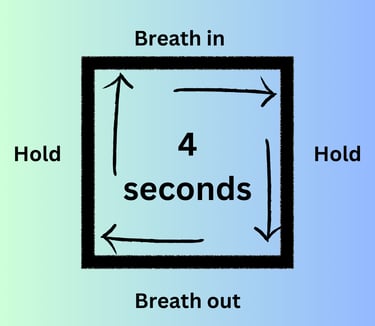We all have those days when that one particular kid seems to be on a mission—pushing every button like it’s their full-time job. You’d swear their life’s purpose is to see just how far they can go before Mom finally snaps and transforms into a screaming maniac.
So, what’s a mom to do? Here are four tried-and-true ways to keep your cool when your patience is running on empty.


We’ve all heard it before—“Just take a deep breath.” But when anxiety is surging, that simple advice might feel like an oversimplified solution. However, science backs up this practice: deep breathing is one of the most effective tools we have to calm our minds and bodies. Understanding the neurological effects of deep breathing can be a powerful motivator to incorporate this technique into daily life.
Deep breathing activates the parasympathetic nervous system, which is responsible for the body's "rest and digest" state. This process counteracts the fight-or-flight response, slowing down the heart rate and promoting a sense of calm.
Deep breathing increases oxygen flow to the brain and helps restore activity to the prefrontal cortex, enabling logical thinking and reducing impulsive, emotionally driven reactions. 👈This is key!
When I heard this, it made the whole deep breathing thing make sooooo much sense! In order for me to think rationally, the rational part of my brain needs to be in the drivers seat. If the emotional side of my brain is in control, I am reactive, and kind of childish myself. So how do I quiet the emotional, reactive side of my brain that lights ups like a Christmas tree when my kid(s) push my buttons?


1. Box Breathing (Four-Square Breathing)
This method is used by Navy SEALs and athletes to regulate stress levels:
Inhale for four seconds
Hold for four seconds
Exhale for four seconds
Hold for four seconds
Repeat for a few minutes
2. Diaphragmatic Breathing (Belly Breathing)
Instead of shallow chest breathing, focus on expanding your diaphragm:
Place one hand on your chest and the other on your stomach
Inhale deeply through your nose, making sure your belly expands (not your chest)
Exhale slowly through your mouth
Repeat for several minutes
A baby naturally breathes this way. Watch their belly rise and fall. It is how we are designed to breathe. It might take some practice, but work on returning your breathing to default with intentional belly breathing.




When frustration rises, having a simple phrase to repeat can ground you and stop you from snapping. A mantra is a short, calming phrase that you repeat to yourself in moments of stress to ground your emotions and shift your mindset. In the midst of toddler meltdowns, sibling battles, or dinner-time disasters, having a go-to mantra can help you pause, reset, and respond rather than react.
A mantra acts as a mental anchor, engaging the prefrontal cortex (the rational part of the brain) and helping us shift from reactive to thoughtful responses much like deep breathing.
Research shows that repeating calming words or phrases lowers cortisol levels (the stress hormone), slows breathing, and reduces anxiety.
How to Create a Mom Mantra That Works For You
The best mantras are short, positive, and easy to remember. Here are a few tips for crafting one:
Keep it simple. A mantra should be easy to repeat in the heat of the moment.
Make it personal. Choose words that resonate with you and your parenting style.
Focus on positivity. A good mantra should reinforce patience, love, or resilience.
Examples of Effective Mom Mantras
If you need inspiration, here are a few tried-and-true mantras that many parents use:
This too shall pass. (Great for reminding yourself that tough moments are temporary.)
Breathe in calm, breathe out stress.
I am the calm in the storm. (A reminder that you set the emotional tone for your home.)
Pause before you react.
They’re just kids, they’re still learning.
Find one that works for you and use it like a lifeline. Whisper it, chant it, or even shout it into a pillow if necessary.
Getting curious when your child is acting out might feel like a challenge at first, but it can truly transform your approach to parenting. Instead of reacting impulsively or with frustration, curiosity allows you to pause and dig deeper into the why behind their behavior. It's about taking a step back, and choosing to understand what’s really going on with them—whether they’re 3 or 13.
Look For the Need
Ask yourself questions like:
What might be going on behind this behavior?
What is my child trying to communicate with their actions?
Could there be something they’re struggling with that I don’t know about?
It could be something as simple as they’re hungry or tired, or it might be something deeper, like feeling overwhelmed or needing more attention from you. By pausing, you’re already setting the stage for a more mindful response.
As moms, we are our children’s safe space to express these emotions. Instead of taking their behavior personally, try to look for the emotional need beneath it.
Model Calmness and Problem Solving
Getting curious about your child’s behavior not only helps you stay calm, but it also teaches your child valuable emotional skills. When you model curiosity and calmness in the face of challenging behavior, you're showing your child how to approach difficult emotions in a healthy way.
For instance, instead of saying, “Stop whining, I’ve told you this a million times,” you can say, “I see that you’re really upset right now. What’s going on?” By framing your response this way, you open the door for conversation, empathy, and problem-solving.
Remember, your child is not trying to annoy you on purpose. They are simply navigating their emotions, and they need our guidance.


When you feel like you're close to snapping, know that you have the tools to handle the situation with calm and clarity. But the truth is, there is no such thing as a perfect mom and inevitably we all lose our cool at some point. It's important to give yourself grace. It's also a good idea to model apologizing sincerely. You are showing them how to make things right when they lose their cool.


